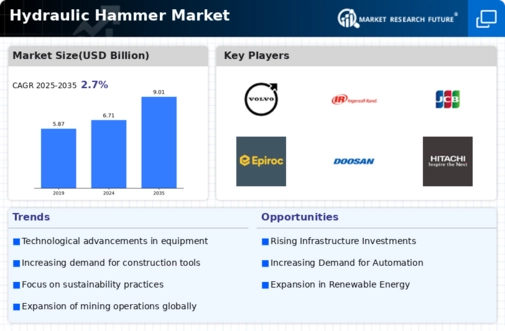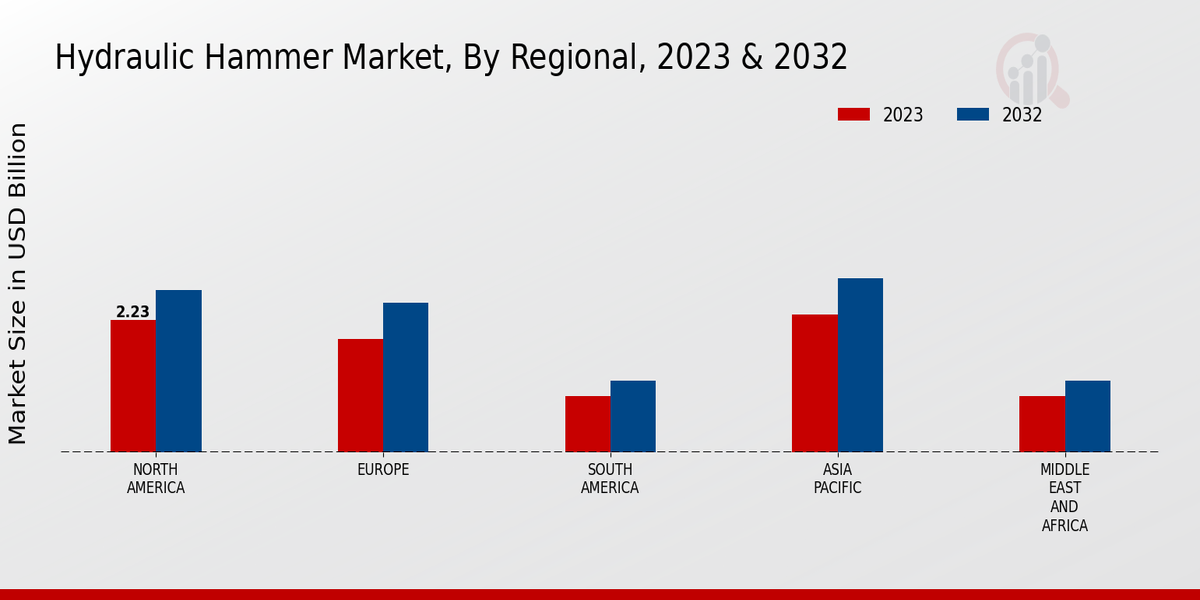Growing Urbanization
Urbanization is a critical factor contributing to the growth of the Global Hydraulic Hammer Market Industry. As populations migrate to urban areas, the demand for residential and commercial construction rises, necessitating the use of hydraulic hammers for efficient demolition and construction processes. This trend is particularly evident in developing countries, where rapid urbanization is leading to increased infrastructure projects. The market is expected to witness a compound annual growth rate (CAGR) of 2.71% from 2025 to 2035, indicating a steady demand for hydraulic hammers in urban development initiatives. Consequently, manufacturers are likely to focus on producing versatile and durable hydraulic hammers to meet this growing demand.
Technological Advancements
Technological advancements are significantly influencing the Global Hydraulic Hammer Market Industry. Innovations in hydraulic hammer design, such as improved energy efficiency and reduced noise levels, are attracting attention from construction and demolition companies. These advancements not only enhance performance but also comply with stringent environmental regulations. For instance, the introduction of smart hydraulic hammers equipped with sensors for real-time monitoring is gaining traction. Such technologies can optimize operations and reduce downtime, thereby increasing the overall efficiency of construction projects. As these innovations continue to emerge, they are likely to drive market growth and attract new investments.
Market Trends and Projections
The Global Hydraulic Hammer Market Industry is poised for growth, with projections indicating a market value of 6.71 USD Billion in 2024 and an anticipated increase to 9.01 USD Billion by 2035. This growth trajectory suggests a compound annual growth rate (CAGR) of 2.71% from 2025 to 2035. The market dynamics are influenced by various factors, including infrastructure development, mining activities, and technological advancements. As these trends continue to evolve, stakeholders in the hydraulic hammer market are likely to adapt their strategies to capitalize on emerging opportunities and address challenges in a competitive landscape.
Rising Demand in Mining Sector
The mining sector plays a pivotal role in the expansion of the Global Hydraulic Hammer Market Industry. With the continuous extraction of minerals and resources, hydraulic hammers are essential for breaking rock and facilitating excavation processes. The increasing demand for minerals, particularly in emerging economies, is propelling the need for efficient and powerful demolition tools. As mining operations expand, the market for hydraulic hammers is projected to grow, with estimates indicating a market value of 9.01 USD Billion by 2035. This growth reflects the essential role hydraulic hammers play in enhancing productivity and operational efficiency in mining activities.
Increasing Infrastructure Development
The Global Hydraulic Hammer Market Industry is experiencing growth driven by the surge in infrastructure development projects worldwide. Governments are investing heavily in transportation, energy, and urban development, leading to a higher demand for construction equipment, including hydraulic hammers. For instance, the global infrastructure spending is projected to reach approximately 6.71 USD Billion in 2024, creating a favorable environment for hydraulic hammer manufacturers. This trend is expected to continue, as infrastructure projects are essential for economic growth and urbanization. As a result, the hydraulic hammer market is likely to benefit from increased orders and sales in the coming years.
Environmental Regulations and Sustainability
The Global Hydraulic Hammer Market Industry is increasingly influenced by environmental regulations and the push for sustainability. Governments worldwide are implementing stricter regulations to minimize noise pollution and environmental impact from construction activities. Hydraulic hammers that comply with these regulations are becoming more sought after. Manufacturers are responding by developing eco-friendly hydraulic hammers that reduce emissions and noise levels. This shift not only aligns with regulatory requirements but also appeals to environmentally conscious consumers and businesses. As sustainability becomes a priority in construction practices, the demand for compliant hydraulic hammers is expected to rise, further driving market growth.



 Source: Primary Research, Secondary Research, MRFR Database and Analyst Review
Source: Primary Research, Secondary Research, MRFR Database and Analyst Review




















